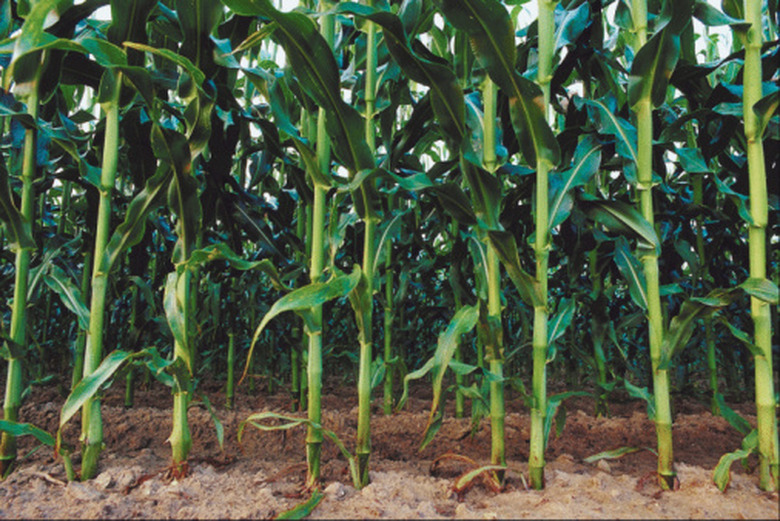My Corn Plants Don't Grow Tall
Corn is known for growing into over-sized stalks that tower above peoples' heads, so finding corn that is stunted and short can be disheartening to a grower. A few environmental factors can explain corn stalks that won't grow tall, but it's not the end of the world when it comes to harvest. You may still reap a hefty amount of grain from short corn.
Temperature
Corn grows by expanding its internode cells during its late growth stage when it does much of its stretching. The stalk elongates as the internodes grow. While shading can boost this growth, cool temperatures may slow it down by effecting cellular rigidity, stunting the plant's height and foliage for the rest of the season. Fortunately, leaf size at this point will not affect grain size. The new leaves that are emerging at the top of the plant will contribute to grain size, and these will continue to grow if conditions permit. But continued cool weather may slow down leaf development, resulting in fewer leaves and limiting corn's growth.
- Corn is known for growing into over-sized stalks that tower above peoples' heads, so finding corn that is stunted and short can be disheartening to a grower.
- The new leaves that are emerging at the top of the plant will contribute to grain size, and these will continue to grow if conditions permit.
Soil
Soil compaction can create over-saturated conditions and stunt corn plant growth. Compacted soil restricts root development and disturbs its growth, forcing it into lateral branching. Plants in overly watered soil can also exhibit development and growth issues and appear stunted. Another possible soil problem is nitrogen deficiency. Corn demands a lot of nitrogen. Adding a nitrogen fertilizer to soil to replenish this nutrient may help corn that appears shorter than expected.
Yield
Unless your short corn plants are nutrient-deficient or suffering from excess moisture, short corn stalks should not alter yield amount. As long as the growth problem is related to shorter internodes, it will not affect grain size. Remember that some corn varieties are early hybrids that are ultimately shorter and have smaller yields than full season types.
- Soil compaction can create over-saturated conditions and stunt corn plant growth.
- Adding a nitrogen fertilizer to soil to replenish this nutrient may help corn that appears shorter than expected.
Growing Corn
Corn is a heavy feeder that loves nitrogen, so it needs well-tilled and fertile soil. The plant prefers soil temperatures of at least 65 to 75 F and night temperatures above 60 F. To protect against cold and frost, install a fabric floating row cover with hoops supporting it. Avoid planting corn in overly moist soil because it can damage and stunt the crop. Planting corn too early or late in the year may reduce the corn's height and yield. The type of hybrid planted plays a large role in growth rate and stalk height as well.
